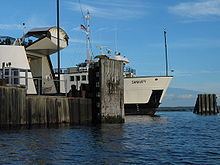Out of service 1964 Draught 9.6 ft (2.9 m) Length 59 m | Fate sunk in 1964 Launched 1911 Draft 2.93 m | |
 | ||
Beam 32 ft (9.8 m) (at water line) 36 ft (11 m) (on deck) | ||
Steamship authority ferry eagles crashes into vessel sankaty hyannis ma 12 04 11
Sankaty (a.k.a. HMCS Sankaty, a.k.a. Charles A. Dunning) was a propeller-driven steamer that served as a ferry to Martha's Vineyard and Nantucket in Massachusetts; in Rockland, Maine; Stamford, Connecticut and Oyster Bay, Long Island; Staten Island, New York; Wood Islands, Prince Edward Island and Caribou, Nova Scotia; and served as a minelayer for the Royal Canadian Navy during World War II.
Contents
- Steamship authority ferry eagles crashes into vessel sankaty hyannis ma 12 04 11
- Sankaty head lighthouse bike tour oct2014 boston cape cod nyc
- Construction and career
- Marthas Vineyard and Nantucket Ferry
- 1924 fire Maine and New York Ferry Service
- Canadian service and fate
- The new Sankaty
- References
Sankaty head lighthouse bike tour oct2014 boston cape cod nyc
Construction and career
Sankaty was designed by Chauncey G. Whiton, built by the Fore River Works in Quincy, Massachusetts and launched in 1911. It was 188 feet (57 m) long, a slim vessel with twin propellers and twin smokestacks. She had a 36-foot (11 m) beam, and drew 9 feet 6 inches of water.
Martha's Vineyard and Nantucket Ferry
From her construction in 1911 until 1924, Sankaty operated as a ferry serving the islands of Martha's Vineyard and Nantucket. While not the first propeller-driven steamer to serve these islands (which was Helen Augusta which substituted for Monohansett during the Civil War) it marked the end of the paddlewheel steamer era for the Cape and Islands.
Sankaty rolled much more than the sidewheelers that preceded it. Because of this, the ladies' parlor and toilet was situated on the upper deck in a location to reduce the motion and vibration while on the rough waters of Vineyard Sound.
1924 fire, Maine and New York Ferry Service
On the night of June 30, 1924, Sankaty caught fire and burned down to her steel hull while tied up overnight in New Bedford harbor. She drifted across the Acushnet River in flames and crashed into the famous whaling ship Charles W. Morgan, setting her on fire as well.
Sankaty was raised, sold and rebuilt with an open deck for use as a car ferry in Rockland, Maine. A few years later she was sold again to serve as a ferry between Stamford, Connecticut, and Oyster Bay, Long Island. She also evidently served as a Staten Island Ferry.
Canadian service and fate
In 1941 Sankaty was purchased by Northumberland Ferries of Prince Edward Island, Canada, but before she began service she was requisitioned by the Royal Canadian Navy to serve in World War II as a minelayer, HMCS Sankaty. After the war she was renamed Charles A. Dunning, and served from 1946 until 1964 in the waters between Wood Islands, Prince Edward Island and Caribou, Nova Scotia. During this period her capacity was twenty-three cars and four trucks. She was sold for scrap in 1964, but sank en route to Sydney, Nova Scotia.
The new Sankaty
In 1994, The Woods Hole, Martha's Vineyard and Nantucket Steamship Authority began service of a new freight vessel Sankaty, named after this old steamer.
